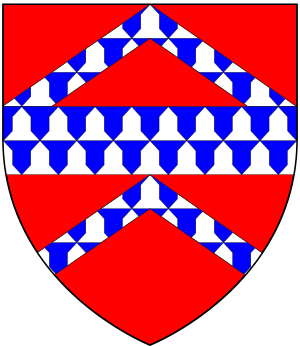Samuel Goodere facts for kids
Samuel Goodere (born 1687, died 1741) was a captain in the British Royal Navy. He was the third son of Sir Edward Goodere, 1st Baronet. Samuel Goodere was found guilty and executed in Bristol in 1741. This happened because he was responsible for the death of his older brother, Sir John Dineley Goodere, 2nd Baronet.
Contents
Samuel's Early Life
Samuel Goodere's mother was Eleanor Goodere. Her family, the Dineleys, were quite wealthy. Samuel had several brothers. His oldest brother died in a duel. When Sir Edward Dineley, their grandfather, passed away, the next oldest brother, John, received a large family estate.
Sir Edward Dineley's will mentioned his grandsons, including Samuel and John. The will had specific rules about who would inherit the family fortune. It was mainly meant for John's sons. If John had no sons, then his brother George and his sons would inherit. If neither John nor George had male heirs, then Samuel and his sons would be next in line.
However, John Goodere did not follow the will's rules. He decided to leave his estate to his sister Eleanor Foote's son instead. Both John and Samuel Goodere served as Mayors of Evesham at different times. A lawyer friend, Jarrett Smith, later became involved in the sad events between the brothers.
Samuel joined the navy in 1705. He started as a volunteer on a ship called HMS Ipswich. He served in different roles during the War of the Spanish Succession. In 1719, he became a first lieutenant on HMS Preston. He then moved to HMS Weymouth and HMS Deptford.
Later in 1719, Samuel faced a problem. His captain accused him of not doing his duty during an attack on San Sebastián. Samuel was put on trial by a navy court. He was found guilty of "not performing his duty well." Because of this, he was removed from his ship. This was a very serious punishment, almost like being kicked out of the navy during peacetime.
It is not clear if Samuel served at sea again for many years. He might have lived with his father, Sir Edward Goodere. His father and older brother, John, did not get along well. John was described as "rough" and "uneducated."
When their father, Sir Edward Goodere, died in 1739, John inherited the title of Baronet. Samuel also received some money from his father's estate. However, the brothers disagreed about the money. John thought Samuel got too much, and Samuel thought he got too little. They argued a lot. John's son later passed away. After this, John said he would leave his property to one of his sister Eleanor's sons. This made the conflict between John and Samuel even worse.
The Brothers' Conflict
In November 1740, Samuel Goodere was given command of a ship called HMS Ruby. The ship was docked near Bristol. On January 18, 1741, Samuel was on land. He found out that his brother, Sir John, was having dinner with a lawyer named Jarrett Smith. Sir John was on his way to Bath because he was not feeling well.
Samuel sent a note to Smith, asking to join them. He said he would be happy to see his brother. So, that evening, Samuel went to Smith's house. The two brothers spent time together, smoking and drinking. John only drank water. It seemed like they had made up their quarrel.
However, as John was walking to his room later, he was taken by force. This happened on Samuel's orders. John was taken to the King's Dock and then rowed out to Samuel's ship, the HMS Ruby. He was locked in a small cabin. Samuel told the sailors on deck to ignore John's calls for help. He claimed John was confused and needed to be watched.
Three sailors were chosen to guard John. They were given a lot of brandy and promised big rewards. Early the next morning, January 19, 1741, these three men went into the cabin. They caused Sir John's death using a rope. Samuel stood guard at the door with a sword to stop anyone from interfering. A couple in the next cabin heard and saw some of what happened through gaps in the ship's walls.
Samuel Goodere had planned to sail away quickly. But Jarrett Smith became suspicious. He had heard that a gentleman like his guest had been taken onto the Ruby. Smith told the mayor, who started an investigation. Samuel Goodere and the three sailors were arrested. They were all put on trial on March 26. They were found guilty and sentenced to face serious punishment. They were executed on April 15, 1741.
Samuel's body was later buried with his family in Hereford. Papers about the events are kept at Bristol Archives.
Samuel's Family
Samuel Goodere had a daughter named Eleanor. He later married Elizabeth Watts and had three more daughters and twin sons. Two of his daughters never married. The third, Anne, married a navy commander named John Willyams. She was the mother of a famous reverend, Cooper Willyams.
The older twin son, Edward, inherited the family title after his father's execution. Edward died in 1761 in London. He was unmarried and had a mental illness. The other twin son, John, lived until 1809. He lived at Windsor Castle as one of the "Poor Knights of Windsor."
Family Titles
Even though Samuel Goodere seemed to be next in line for the family title, he did not use it. During his trial, he was called "Mr Goodere." Some historians believe the family title ended in 1741 when Samuel Goodere was sentenced. Others thought his sons inherited the title from their uncle, not their father. It is a bit confusing, but it is likely the title ended in 1741.


